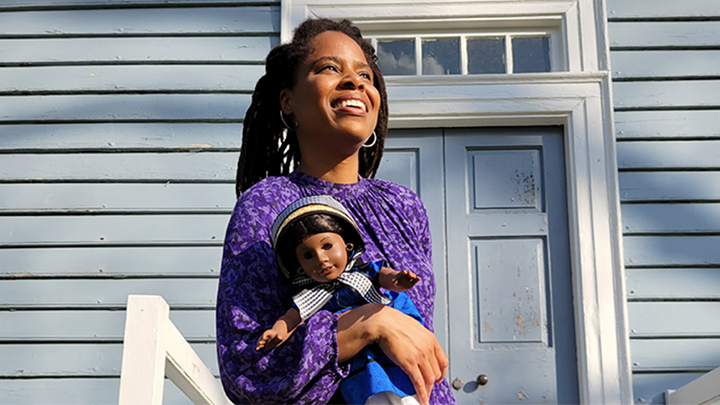Exploring girlhood and culture through Black dolls
Assistant professor explores history through the lens of the girl child to highlight scholarly research in girlhood studies

Scholarly research at San Diego State University covers diverse topics including girlhood studies, where undergraduates, faculty and graduate students analyze literature related to this niche area.
Lashon Daley, director of the National Center for the Study of Children's Literature, is passionate about dolls, Black dolls specifically, because of how dolls reveal the link between girlhood and consumership in U.S. culture. Daley’s current research focuses on the controversial Addy doll, the American Girl line’s first Black doll, introduced in 1993.
“What the American Girl experience taught me is that girlhood in the U.S. is rooted in consumerism and overconsumption,” Daley said. “That girlhood is part fantasy, part reality, and part brand. I also learned about the importance of understanding American history through the lens of the girl-child.”
One of the American Girl book series features Addy Walker (1864-1866), an enslaved girl who ran away with her mother to find freedom in Philadelphia during the American Civil War. The six-book series was written by Connie Rose Porter and published in 1993 and 1994.
Daley’s pursuit of in-depth scholarship led her on a 10-day research journey last year, where she retraced Addy’s path to freedom laid out in “Meet Addy,” the first book of the series. Daley also used the National Park’s Underground Railroad Trail as an additional guide.
Daley visited such historical sites as the Contrabands and Freedmen Cemetery Memorial in Alexandria, Virginia; Colonial Williamsburg, Virginia; the National Mall in Washington, D.C.; and the Belmont Mansion and the Institute for Colored Youth in Philadelphia.
By creating videos on YouTube about her research, Daley has opened up a new national and international audience interested in girlhood studies. The platform allows for engagement and connection through the videos that document her research and travels in an accessible style. In a surprise twist, one such research video garnered the attention of Porter, the Addy series author. Appreciative of Daley’s research efforts, Porter emailed Daley thanking her for her work.

“I am moved and impressed by the amount of time and research you put into this project,” Porter wrote. “There is so much to love about the video, the retracing of Addy’s steps, the trips to historical sites, plantations, museums, and even going to Mother Bethal [sic].” She added that she “felt the emotion as you headed down the Underground Railroad Trail and into the woods.”
During her research trip, Daley carried a full-size Addy doll and received positive feedback from people she met along the way.
“How to play with Dolls” is part of her girlhood studies course, Adolescence in Literature (ECL 502), where in spring, 37 students were introduced to a survey of research in girlhood studies. The course covered topics about the definition of girlhood studies, how girlhood culture has changed throughout the years and is represented differently based on cultural backgrounds. Assigned book readings included “Merci Suárez Changes Gears” by Meg Medina, “Hearts Unbroken” by Cynthia Leitich Smith, and “The Hate U Give” by Angie Thomas.
Diamond Cofer, a master’s student in English, wrote, “Prior to this course, I never really thought about girlhood studies and honestly didn’t even know such studies were a thing.”
Class discussions included a review of “the doll test,” a popular 1940s study used to win the 1954 landmark case, Brown v. Board of Education. In the study, researchers Kenneth and Mamie Clark asked their young participants to point to the dolls that were seen as bad. Most of the children pointed to the Black dolls.
“As we learn more about the topics, we really debunk certain ideas that have followed many of us from childhood to adulthood, and how many of those beliefs are due to the patriarchy of society,” Cofer added. “Personally, I also love the fact that interests I’ve grown up with, such as Bratz Dolls, Kim Possible, and Polly Pockets, have appeared in the class discussions at times.”
Cofer’s research is inspired by Daley.
“I will forever be grateful for having the opportunity of taking ECL 502, meeting Dr. Daley, and being exposed to a new research topic that I not only can relate to but have become so passionate about,” Cofer added.



